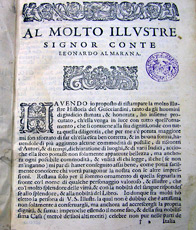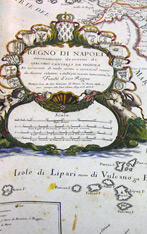| ||||||||||||||||||||
The ancient library of the Real College
After being been shut for over forty years, was reopened to the public only a few decades ago. Also this precious property exists for the will of the founder of the college. When in 1767, by order of Ferdinand III , the Jesuits were chased out of Sicily, while everyone was trying to take possession of their State goods, to the Capizzi were given several volumes confiscated from the Company libraries of Palermo, very precious book property indeed, part of which is today kept into the College library. The shelves, filled with over 21 thousand volumes, between scientific, literary, philosophical and theological texts, offer precious editions of very great interest that gives a clear testimony of the degree of culture reached in the life of the college. Among the works of inestimable value is worth mentioning an
| ||||||||||||||||||||
| ||||||||||||||||||||
Besides a historical archive of inestimable value, unique in Bronte, the library of the Capizzi College, contains over 20 thousand volumes. There are also many Latin and Greek classics from Svetonio, twelve Caesars (1548) to works by Xenophont (1581), Tacitus, Velleious Paterculus, Plutark, Valerious Maximum (1557), Plinius (1741) Lucretius (1807), Ovidius (1806) and Sallustius (1813). In the photos a few precious editions of really great interest:
The Library of the Real Capizzi College, besides a priceless historical archive, holds over 21 thousand books scientiphic, literary, philosophical and theological, with Greek, Latin, Italian, English, Spanish, German and French texts. It is evident the high grade of culture reached in the centuries by the College and the level of scholastic formation that was there furnished. In the shelves of the library is also preserved a copy of the "Teatro Contemporaneo" (Contemporary theatre) of Luigi Capuana, with autographic dedication of the writer (He had studied in the Capizzi college having as professor, among others, father Gesualdo De Luca): «at the library of the college of Bronte as little expiation of all my escapades of collegiate. Mineo, April 7th, 1872». The Library Of The Real Capizzi College is generally open every day from 9 AM to 1 PM. Responsible for the library is Franco Cimbali, who, from his illustrious ancestors (the brothers Enrico, Eduardo, and Giuseppe) inherited the passion for books with the fussiness and the historian' s precision in his continuous archive searches on the history of his country town. | ||||||||||||||||||||||
| ||||||||||||||||||||||
| ||||||||||||||||||||||
 The college library, organized as Temple of Knowledge, contains almost all the works that constituted the humanistic culture of the XVIII century.
The college library, organized as Temple of Knowledge, contains almost all the works that constituted the humanistic culture of the XVIII century.




















